‘Fist’ offense beats up man defenses
“Fist” provides a different look that’s effective against man defenses. This set confuses defenses by what it does not do.
There is a three-player stack that’s somewhat stationary, as in a lot of pro sets. Many defenders expect motion and movement, and they often become “jittery” when standing still. They also are trying to determine whether to leave in “help” fashion or to hold position on their own player.
Basic movements
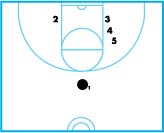
DIAGRAM 1: Initial set. The 3, 4 and 5 players form a diagonal stack on the right side of the lane, starting from the low post. The 2 guard should start on the left low post, as 1 advances the ball up the floor.
I also have used this set effectively against zone defenses by moving 2 off of the low post and into the wing area.
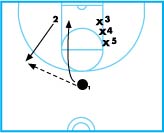
DIAGRAM 2: Opening moves. 2 flashes to the wing to receive the pass from the 1. Coach your 2-guard to extend an open hand to receive the pass, or extend a closed hand if he or she plans on going backdoor. The backdoor cut is very effective when the defense is overplaying the wing flash cut.
When 2 receives the pass, 1 cuts down the lane executing a give-and-go with 2. If 1’s defender does not jump to the ball on the pass, the cut to the basket should be open. This starting motion is the same for every special in this set. It puts great pressure on the defenders playing the guards, and it forces the remaining defenders to play off the stack setting up the other specials.
If the give-and-go is not open, 1 comes back toward 2 and sets up a pick-and-roll, or continues to the opposite corner and lets 2 go 1-on-1 against his or her defender. Make sure to coach your 3, 4 and 5 players to hold their positions.
Fist ‘2 special’
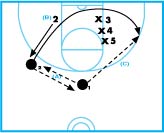
DIAGRAM 3: Fist 2 (initial motion). This special starts with the same stack configuration. 2 breaks to the wing to receive the pass from 1. If overplayed, 2 again can go backdoor. If not overplayed, 2 receives the ball on the wing and passes back to 1 (A) then cuts below and around the stack (B) to receive the ball for a 3-point attempt (C).
 DIAGRAM 4: Breaking the stack. If 2 cannot get an open 3-point look from the wing, 3 must cut to the opposite wing. 1 cuts toward 3 and sets a screen (A) allowing 3 to break to the top of the key to take a pass from 2 for a shot (B).
DIAGRAM 4: Breaking the stack. If 2 cannot get an open 3-point look from the wing, 3 must cut to the opposite wing. 1 cuts toward 3 and sets a screen (A) allowing 3 to break to the top of the key to take a pass from 2 for a shot (B).
4 dives for the low post, and 5 posts hard at the elbow. This sets up a post entry or a high-low entry if the other options are not available.
Fist ‘3 special’
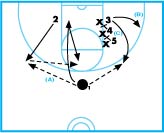 DIAGRAM 5: Attack from the stack. 2 flashes to the wing looking for the backdoor cut, or receives a pass from 1 and looks for the give-and-go with 1 (A). If this isn’t available, 1 returns to the top of the key and 2 passes the ball back. On this pass, 3 uses the double stack set by 4 and 5 as a double-screen.
DIAGRAM 5: Attack from the stack. 2 flashes to the wing looking for the backdoor cut, or receives a pass from 1 and looks for the give-and-go with 1 (A). If this isn’t available, 1 returns to the top of the key and 2 passes the ball back. On this pass, 3 uses the double stack set by 4 and 5 as a double-screen.
If the player defending 3 is screened, or attempts to go around the stack, 3 should be open using a flare cut (B). If 4 and 5 screen down, and the extra defender chases 3, 4 reverse pivots and seals the defender (C) for an entry. If 3’s defender evades the screen and chases 3, then 3 should be able to use the double-screen and curl into the lane for a pass and basket.
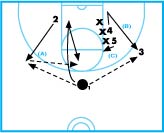 DIAGRAM 6: Fist 3 (hi-lo option). This special starts in the same stack configuration and with the normal flash-and-return initial move. On the return pass to 1 (A), 3 cuts hard to the wing to receive the pass (B). 4 dives hard to the low post, and 5 seals at the elbow (C).
DIAGRAM 6: Fist 3 (hi-lo option). This special starts in the same stack configuration and with the normal flash-and-return initial move. On the return pass to 1 (A), 3 cuts hard to the wing to receive the pass (B). 4 dives hard to the low post, and 5 seals at the elbow (C).
Since the defenders were to the basket side before the wing pass, 4 and 5 should be able to seal and receive an entry pass. If either is fronted, the lob may be open. The ball may also be passed to 5, then dropped to 4 in the post.
Fist ‘lob special’
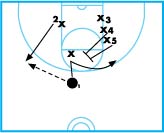
DIAGRAM 7: Looking for the lob. Lob starts in the normal stack configuration. 2 again breaks to the wing to receive the pass, still going backdoor if overplayed. On the initial pass, 4 and 5 break from the stack and form a double-screen at the top of the key. 1 cuts off the screen.
If 1’s defender is picked off or goes below screen, 1 is left alone for a great shot opportunity.

DIAGRAM 8: Setting up the lob. If the defender fights through the screen, or 1 doesn’t get the ball, 1 circles under and clears to the opposite corner. 4 continues to the top of the key after the screen to receive a pass from 2. 5 stays at the elbow, posting up high.
4 passes back to the 2 (A). On this pass, 3 sets a back screen for 5, who rolls toward the rim looking for a lob from 2 (B). After setting the screen, 3 reverse pivots and looks for an entry in to the paint (C).
Fist ‘4 special’
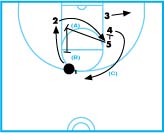 DIAGRAM 9: Pick-and-roll off the stack. Start in the normal stack configuration, but if the give-and-go action doesn’t work, 1 returns to the elbow with the ball and 2 goes to the low post.
DIAGRAM 9: Pick-and-roll off the stack. Start in the normal stack configuration, but if the give-and-go action doesn’t work, 1 returns to the elbow with the ball and 2 goes to the low post.
5 screens across for 2 (A). 2 replaces 5 in the stack, then 5 moves to the elbow to run a pick-and-roll with 1 (B). As the pick-and-roll starts, 3 moves just outside the short corner. If the pick-and-roll doesn’t work, 2 screens for 4, who then pops to the top of the key (C).
 DIAGRAM 10: Finishing strong. 1 reverses the ball to 4 at the top of the key. If open, 4 takes the shot. If not, 2 screens for 3, who takes a wide route to the lane. 5 screens for 2, who rolls into the lane. 4 now has several passing options.
DIAGRAM 10: Finishing strong. 1 reverses the ball to 4 at the top of the key. If open, 4 takes the shot. If not, 2 screens for 3, who takes a wide route to the lane. 5 screens for 2, who rolls into the lane. 4 now has several passing options.









